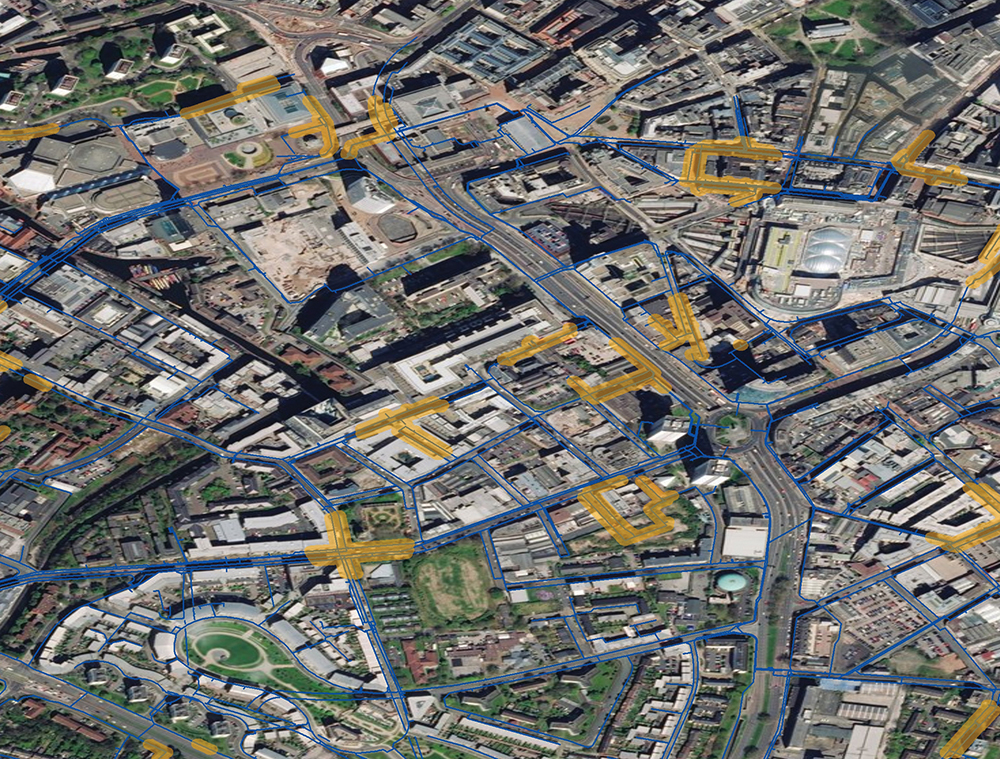Researchers analyzing RADAR signals gathered over three years from the European Space Agency’s Mars Express spacecraft discovered a large lake of salty water buried deep below the surface of Mars. This seems like science fiction, but water agencies are using the same technology here on earth. The difference is that water agencies, such as Severn Trent in the UK, are not looking for underground lakes; they are looking for leakage from their drinking water distribution pipes.
Severn Trent Water (STW) is one of the largest water companies in the United Kingdom. They serve almost 8 million customers through 4 million service connections. STW owns and maintains 47,000 km of distribution and transmission mains and serves large metropolitan areas such as Birmingham. STW has some of the lowest water rates in all of the UK, thus there is little financial incentive for customers to actively conserve water. In addition, STW has many of the same drivers as other water companies around the world; ageing infrastructure, population growth and climate change. Very cold weather followed by a quick thaw last winter caused havoc in the system and leakage skyrocketed.
STW delivers two billion litres of water every day to their customers and over the past ten years the company has reduced leakage by 20%. The utility regulator in England, Ofwat, has mandated that all water utilities must further reduce their NRW leakage by an additional 15% by 2025. STW is committed to exploring all available viable technologies to accomplish this goal, including using drones and satellites to help spot leaks. STW has also announced a multi-million pound plan to install new acoustic monitoring devices in the pipe network to help prevent bursts.
In 2017 STW began using the Utilis satellite imagery service to detect leaking pipes remotely. This system works the same way as the Mars imagery, illuminating the earth with RADAR waves and collecting and analyzing the returned images to look for underground water signatures. The remote satellite imagery allows leak detection crews to be deployed to specific areas in the system that have the highest likelihood of leaks. This increases the crew’s overall efficiency because they are directed to the areas where there are more likely to be leaks, thus they find many more leaks per crew-day.
A first trial was held in Birmingham and achieved a 26% true positive rate of success. True positive is a measure of success; the number of Utilis identified sites that have at least one leak when investigated. Sometimes first trials in new areas generate lower than expected performance when using Utilis. A number of observations were made during this trial; the manual reporting via leak sheets and recording of findings was time consuming for field operations staff, winter is not the best time to perform this work as it is the busiest time of the year (not just for Santa), and, training and experienced leak detection crews are critical to success.
When the second trial was held, the true positive rate was 70%. Because many Utilis identified sites result in the finding of more than one leak, another success metric is used: leaks per site investigated. The number of leaks found per site investigated was over 0.75 in this trial; in other words, the inspectors find three leaks for every four sites they investigate. Project Manager, Samuel Berry, of Severn Trent is very excited about Utilis; he says, “The technology is very good at finding the many small leaks in the system. That really helps reduce the NRW and ensure we meet our customer expectations to find leaks as quickly and efficiently as possible. The results are especially good at identifying leaks on plastic pipe versus other technologies.”
The second trial was very successful based on a number of performance metrics, and, a great improvement over the first trial. Reasons for this improvement included improvements introduced by Utilis which allowed for digital navigation to points of interest, digital logging of results, and improvements in field operators’ resource skill level. STW also did a good job of explaining how the service worked, making the satellite imagery less magical, identifying an innovation champion from the rank and file that was able to promote the service to the rest of the operations staff.
Using the Utilis satellite image STW found that productivity was increased, the time to find a leak was significantly reduced, and, the cost per leak found was also lowered. The results of the two trials will be further analyzed by STW to document technical efficacy and the value proposition of the Utilis leak detection methodology.



